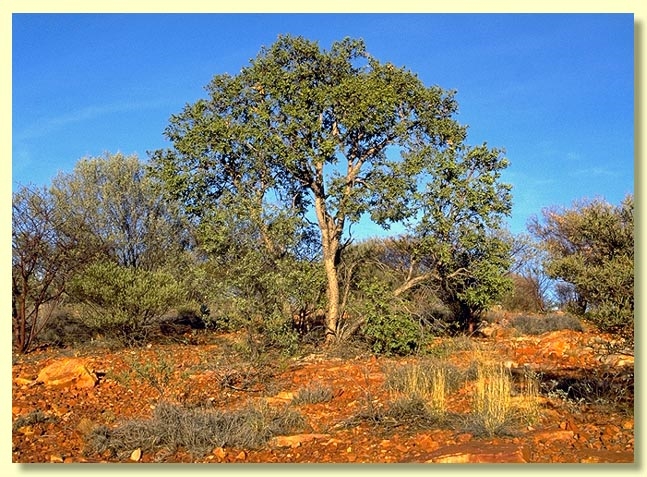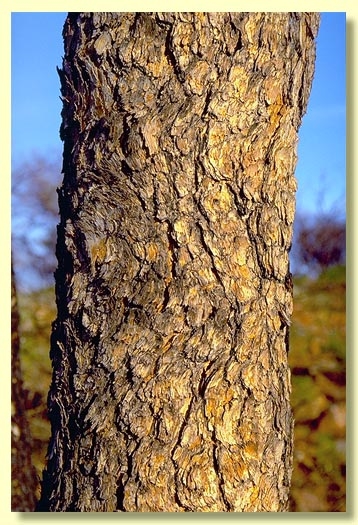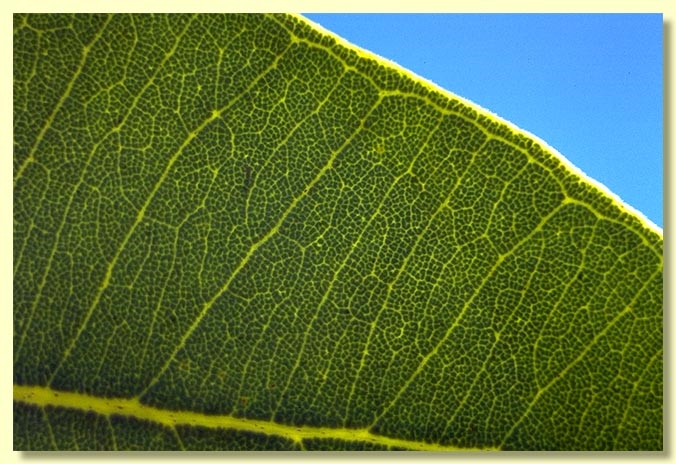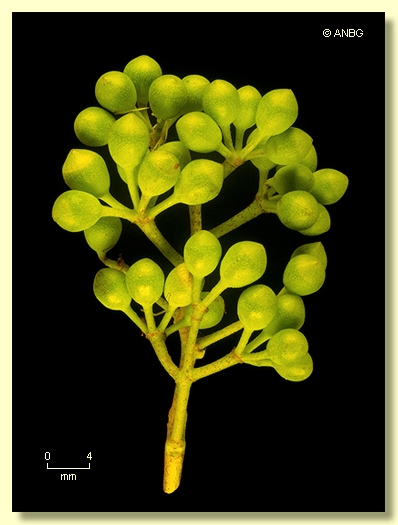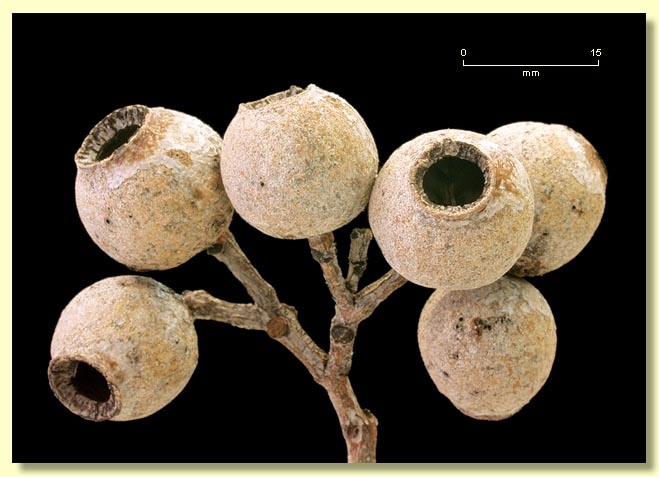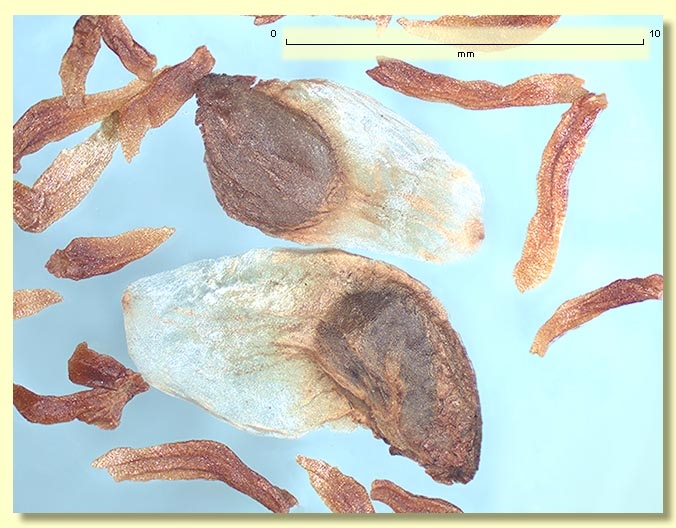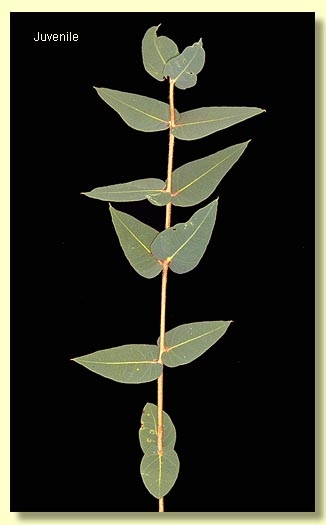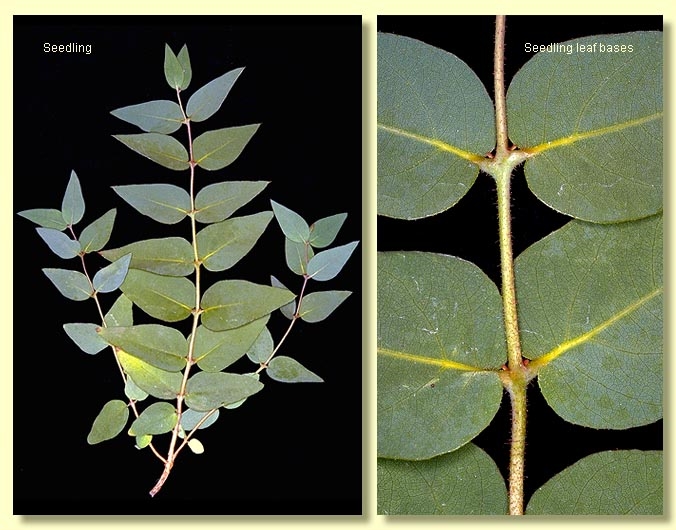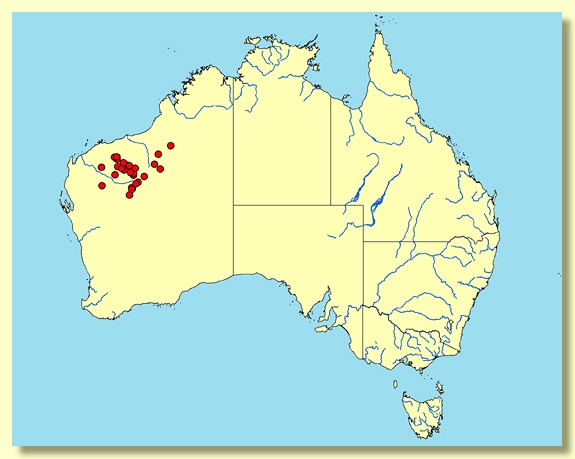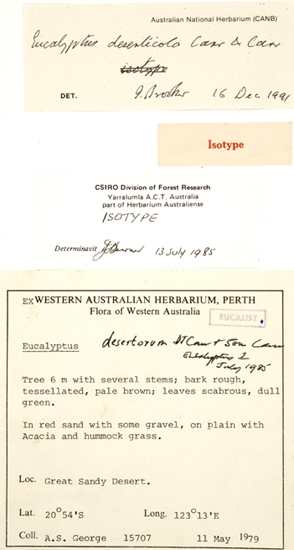Corymbia | Rufaria
Euclid - Online edition
Corymbia deserticola subsp. deserticola
Corymbia deserticola (D.J.Carr & S.G.M.Carr) K.D.Hill & L.A.S.Johnson, Telopea 6: 365 (1995) subsp. deserticola.
Straggly tree or mallee to 6 m tall, but sometimes a shrub only 1 m tall. Forming a lignotuber.
Bark light grey and red-brown, rough and tessellated over trunk and larger limbs to ca 5 cm diameter.
Branchlets lack oil glands in the pith; scabrid to setose, especially on new growth.
Juvenile growth (coppice or field seedlings to 50 cm): stems rounded in cross-section, scabrid and setose; juvenile leaves sessile, opposite, cordate, 3.5–7 cm long, 1.8–4 cm wide, concolorous, green to grey-green, scabrid or sparsely setose on both surfaces.
Adult leaves opposite, sessile or with petioles to 0.5 cm long; blade cordate but sometimes narrower tending to lanceolate, 2–6.2 cm long, 1–3.5 cm wide, stem-clasping, margin entire, apex finely pointed, concolorous, dull, pale green, the surface usually smooth (new growing tips have bristle-glands on leaf surfaces, petioles and stems but these are not apparent when leaves reach full size), side-veins closely placed and at greater than 45° to midrib, reticulation very dense, intramarginal vein present and virtually at the margin or absent, oil glands emergent.
Inflorescence terminal compound, peduncles 0.5–1.2 cm long; buds 7 per umbel, pedicels 0.2–0.6 cm long. Mature buds ovoid to pyriform, 0.5–0.6 cm long, 0.3–0.4 cm wide, sparsely papillose or smooth, scar absent (both opercula shed together at flowering), operculum conical to slightly beaked, stamens inflexed, all fertile, anthers versatile, basifixed, oblong, dehiscing by longitudinal slits, style long and straight, stigma mop-like, locules (3)4, the ovules not arranged in distinct rows on the placentae. Flower colour unknown.
Fruit pedicellate (pedicels 0.1–0.6 cm long), urceolate to truncate-globose, 0.9–1.7 cm long, 0.9–1.6 cm wide, surface slightly roughened, disc descending vertically, valves (3)4, enclosed.
Seeds brown, 8–10 mm long, ellipsoidal with terminal wing, hilum ventral.
Cultivated seedlings (measured at ca node 10): cotyledons large, reniform; stems rounded in cross-section, sparsely to densely setose with bristle-glands; leaves sessile or very shortly petiolate (petiole to 0.3 cm), opposite throughout, cordate, 2.8–7 cm long, 1.4–4.3 cm wide, stem-clasping, lobed or rounded, apex pointed, dull, green, discolorous, sparsely setose to almost smooth. Note that the bristle-glands bear simple hairs on top and sides but these are often short and more like papillae.
Flowering time not known.
Corymbia deserticola is a bloodwood species with tree, mallee or shrub habit found in arid Western Australia and the Northern Territory, from Mount Augustus north of Meekatharra and the Hamersley Range east to the Davenport Range south of Tennant Creek and the Barkly Tableland in the Northern Territory. C. deserticola is found on stony to red sandy sites and, on mountaintops in the Pilbara region can form a low shrub ca 1 m tall with a spread of 3–4 metres. It is characterised by the crown of small, slightly sandpapery juvenile leaves that are sessile or shortly stalked and opposite on the branchlet, smooth to only sparsely papillose buds, and small urn-shaped to globoid fruit 0.8–1.5 cm wide. New leaf growth is hairy (setose).
Two subspecies have been described:
C. deserticola subsp. deserticola
Crown leaves have an acute apex giving an overall cordate to ovate (sometimes approaching lanceolate) appearance and have closely spaced straight side-veins and the intramarginal vein at or very close to the matgin. Occurs in the Pilbara region north from Meekatharra, on rocky hills, laterite slopes and red sand dunes and plains.
C. deserticola subsp. mesogeotica
Differs from subsp. deserticola only in the crown leaves which are more juvenile in form being rounded, not acute, at the apex and thus tend to be more sub-orbicular in shape with major side-veins well spaced and looping at the leaf edge to form the intramarginal vein. It has a more inland distribution, occurring from the Gibson Desert near the WA/NT border through the central Northern Territory to the Barkly Tableland, predominantly on red sands with Triodia.
C. deserticola is likely to be confused with three other species of rough-barked, opposite-leaved bloodwood, C. setosa, C. sphaerica and C. zygophylla. The latter species differs from C. deserticola in the fruit, which are 1.7–3.3 cm wide, and it has longer crown leaves. C. setosa differs from C. deserticola (and C. sphaerica and C. zygophylla) in having setose or bristley buds (the buds of C. deserticola subsp. mesogeotica are smooth or sparsely papillose or warty). C. sphaerica differs from C. deserticola in having larger fruit 2–3.1 cm wide.
C. deserticola was formerly included within a wide-ranging and variable Eucalyptus setosa.
The ghost gum species C. aspera, frequently encountered on rocky ridges in arid areas from the Great Sandy Desert and southern Kimberley region east to about Cloncurry in north-western Queensland, is sometimes confused with C. deserticola, but differs manifestly in having entirely smooth bark or a stocking of tessellated bark and smooth branches, thinner-textured leaves, buds that lose the outer operculum during development, and thin-walled typical ghost gum fruit with wingless, saucer-shaped seed.
MORE ABOUT CORYMBIA
MORE ABOUT RED BLOODWOODS
Corymbia deserticola: Latin desertum, desert and cola, dweller, referring to its arid zone habitat.
subsp. mesogeotica: Greek mesogeotikos, inland.

